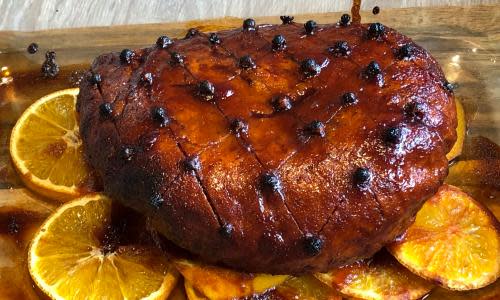Vegan roast roadtest: 'When I wake on Sunday my face smells like vegan ham'

The vegan ham, once cooked, is vibrantly orange. Offensively so, according to my mother, who has left her slice uneaten on the side of her plate. My father has, miraculously, gone back for seconds. He will regret this later.
“I just think the flavour is all right,” he says. “You just have to get over the fact that the texture feels like it’s raw, and feels like you’re eating playdough – which I haven’t done for some time.”
Forcing my parents to trial three different versions of vegan ham was probably unkind. When we were children, my sister and I were not allowed to refuse to eat something until we had at least tried it, leading to one long afternoon at the dining table spent waiting for us to eat some pâté on a biscuit – a particularly middle-class form of child torture.
Were those memories at the fore when I devised this experiment? Possibly. Revenge is a dish best served 25 years late and made of vital wheat gluten.
The purpose of the vegan ham experiment – or vam-off, if you will – was to determine which of three vegan “ham” recipes would be the best porcine replacement at a meat-free Christmas dinner.
The verdict, by universal agreement from two omnivorous boomers (mum and dad) and one vegetarian millennial (me), was: none of them.
The options were: a glazed tofu roast; the bright orange “vegan ham” seitan loaf; and a pre-prepared Field Roast Celebration Roast, also made of seitan and flavoured like turkey stuffing. Watermelon ham was left off the list by virtue of already being proved terrible.
Related: I spent three days making the smoked watermelon ham – but at what cost?
With the exception of the celebration roast, which I fashioned into a chia pet with fresh herbs then roasted as per packet instructions, I cooked the ham alternatives from scratch and take full responsibility for their utter failure.
Who wore it better pic.twitter.com/9ZzbfHhBIm
— Calla Wahlquist (@callapilla) December 8, 2019
Saturday night was spent pressing and marinating the tofu and wrestling with the seitan. Seitan is essentially a dense glutinous bread. Unlike with regular bread, the aim is to make it as tough and heavy as possible. To this end, the recipe recommended using a standing mixer (which I don’t have) and a tight foil wrap during baking, which it escaped.
Despite being flavoured almost entirely by tomato paste and vegetable stock, it has a curiously penetrative scent: when I wake on Sunday my face smells like vegan ham. I wash it again. The smell remains.
Mixin’ up some ham. pic.twitter.com/P22ZCW9aAI
— Calla Wahlquist (@callapilla) December 7, 2019
On Sunday evening, the tofu is baked for an hour, glazed, covered in far too many cloves and baked again for 30 minutes. The seitan-vam – glazed with a combination of tomato paste, maple syrup and yet more liquid smoke – also gets another 30 minutes in the oven.
The reveal
Like every game of make-believe, much hinges on the willing suspension of belief. If you are familiar with the look but not the taste of glazed ham, and you really want to believe this is an acceptable substitute for ham, then you could possibly make that claim. But it’s a bit like eating wax fruit and claiming it tastes like an apple.
If the aim is to create something that looks slightly like a leg of ham, and definitely looks impressively complicated, then seitan is the winner.
Both the vam and the tofu have produced a crackling-like crust. At this point, I am feeling smug. Dad is carefully angling them near the window and climbing on the bench to take photos. This has been a success.
My smugness lasts as long as it takes for dad to take his first bite. The vegan ham, he says, is like “uncooked pizza dough”.
Here’s the insides. pic.twitter.com/Fz2MBOAhHq
— Calla Wahlquist (@callapilla) December 8, 2019
The celebration roast is fine – it tastes like commercial turkey stuffing and is filled with enough salt to keep a family dehydrated for three days – and by universal agreement is the most palatable of the three.
The tofu is flavourless apart from acrid spears sent down by the cloves. Mum says it’s “inoffensive”. Dad thinks it is worse than the seitan loaf but he has never been fond of tofu – he once said tofu was not his favourite food, which in our family is akin to Darryl Kerrigan saying he doesn’t like his wife’s rissoles. Everything is Dad’s favourite.
He is fascinated by the seitan, which manages to taste raw despite being baked for 90 minutes. “The playdough one at least looks a bit like ham, doesn’t it?” he says. “I’m going to eat the bum end of it and see what that’s like.”
The bum is no better.
Mum ranks the seitan “a very poor 57th”, saying it has “an odd flavour and it’s texturally unpleasant”.
That uncooked texture would possibly be resolved if I had any idea what I was doing, but the central problem remains. It is a substance produced by the starship Heart of Gold: almost, but not quite, entirely unlike ham. Failure is writ into the very concept: if you want to eat ham, then eat ham. No amount of manipulation will make plant matter come close.
Related: Nigel Slater’s meat-free Christmas recipes
Nobody wants the leftovers. The dog already has digestive issues, so we decide not to risk it. My parents happily point out that vegan food is at least compostable, and then wonder if the vegan ham will be like the old doormat, which moved house four times in the compost bin before finally breaking down.
I receive permission to make a vegan dish for family Christmas, but only if I don’t attempt to make any part of it in any way resemble meat.

 Yahoo News
Yahoo News 